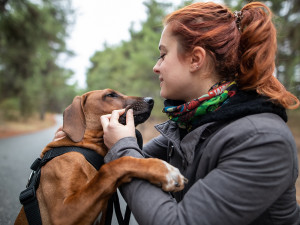Gabapentin for Dog Seizures: Treatment, Dosage, and Side Effects
Everything you need to know about the anti-seizure medication.
Epileptic seizures occur when there is abnormal electrical activity in the brain. Dogs can develop seizures for a number of reasons including toxicity, head trauma, brain tumors, infections, and metabolic disease. If the cause of a dog’s seizures cannot be determined by available diagnostics, they are diagnosed with idiopathic epilepsy. Idiopathic epilepsy just means the cause is unknown, though it is suspected that genetics play a role. Epileptic dogs typically start to have seizures between the ages of one and six.
What are the symptoms of epilepsy in dogs?
Seizures in dogs vary by type and severity, but they can typically be placed into one of three categories: generalized, focal, or psychomotor. Dogs having a generalized (grand mal) seizure lie on their side with stiff limbs and experience rigid, uncontrollable muscle movement. They are unaware of their surroundings and may drool heavily or lose control of their bladder or bowels. Symptoms of generalized seizures include:
Snap a pic of your pup’s teeth, and GREENIES™ will help you spot potential signs of oral health issues.
Stiff limbs
Muscle tremors
Paddling
Drooling or foaming at the mouth
Uncontrolled urination or defecation
Focal, or partial, seizures tend to be less severe and dramatic. Dogs may have head tremors or facial twitches, but are still able to remain on their feet. A common description is “chewing gum seizures.” Psychomotor, or behavioral, seizures can result in abnormal behavior, as if the dog is having hallucinations or abnormal sensations. A common form of this is “fly biting” seizures, in which a dog seems to be snapping at flies that aren’t there.
Treating Epilepsy in Dogs
Dogs with idiopathic epilepsy are managed with medication. If an underlying cause like an infection or brain tumor is found, additional medications or procedures may be needed to control the seizures. Many dogs are managed with just one medication. If the seizures continue despite the medication, the dose can be adjusted or additional medications can be added. Gabapentin is one of many medications used to prevent seizures.
How much do you spend on your pet per year?
What is gabapentin?
Gabapentin is a medication that decreases the activity of nerve cells involved in both seizures and pain recognition. It has many uses in human and veterinary medicine. For dogs, gabapentin is used for seizure control, pain relief, and anxiety reduction. The use of gabapentin in dogs is off-label, meaning it does not have FDA approval.
Gabapentin comes in tablet and capsule form, often in these dosage forms: 100 milligrams, 300 milligrams, or 400 milligrams. It is also available in a liquid form that is used for smaller pets, but extra precautions must be taken to ensure that any liquid gabapentin is pet-safe. Many human formulations contain xylitol, which is toxic to dogs and can cause severe hypoglycemia (low blood sugar) and liver damage.
Gabapentin For Dog Seizures
Gabapentin can be prescribed to treat epilepsy in dogs, but it is not usually a go-to drug for dogs who have frequent generalized seizures. Gabapentin may be used to control focal/partial seizures or as an adjunct medication for generalized seizures if the previous medication regimen isn’t working.
The goal for any anti-seizure medication is to find the lowest effective dose. This means if a veterinarian recommends using gabapentin for seizure control, they will often start at the lower end of the dosage range and increase the dose as needed. Your veterinarian will determine an appropriate dosage based on your dog’s size, seizure frequency, medical history, and current medications. Regardless of the dose, gabapentin is typically given three times a day.
The most common side effects seen after dogs are given gabapentin are sedation and ataxia (wobbly gait). Because gabapentin is rapidly absorbed, these side effects can be seen within an hour or two of administration. Sedation may be more pronounced in dogs already on other anti-seizure medications. While side effects may be seen quickly, the effect on seizure frequency may take days or weeks to be seen.
Considerations For Using Gabapentin to Treat Seizures in Dogs
If your dog has generalized seizures, your veterinarian will likely prescribe other medications as the first line of defense to stop future seizures. If seizures persist, gabapentin or other medications may be added.
Gabapentin is metabolized by the kidneys, so it is a safer choice for dogs who have a history of liver disease, though there are other, more effective medications that don’t affect the liver. In dogs with underlying kidney disease, lower dosing or less frequent dosing may be recommended. Because gabapentin is dosed three times a day, it may not be a good choice for pet parents whose schedules don’t allow for medications every eight hours.
Seizures can be scary events to witness, especially if they are happening to your pup. Luckily, there are many medication options to help get seizures under control. If your dog displays any type of seizure activity, the best plan is to get them to the vet ASAP.
FAQs
1) How long does it take for gabapentin to work for seizures in dogs?
Gabapentin can take days to weeks to have an effect on seizure control, though side effects (like sedation) may be seen soon within two hours.
2) Will gabapentin calm my dog down?
Sedation is a common side effect of gabapentin. The drug is also used to relieve anxiety in some dogs.
4) What does gabapentin do for epilepsy?
Gabapentin helps prevent nerve cells from becoming too excited, which may reduce seizure frequency.
5) Is 300 milligrams of gabapentin too much for a dog?
Gabapentin dosage for dogs depends on their size, medical history, and current medications. Your veterinarian will use this information to determine the safest dosage for your dog.













